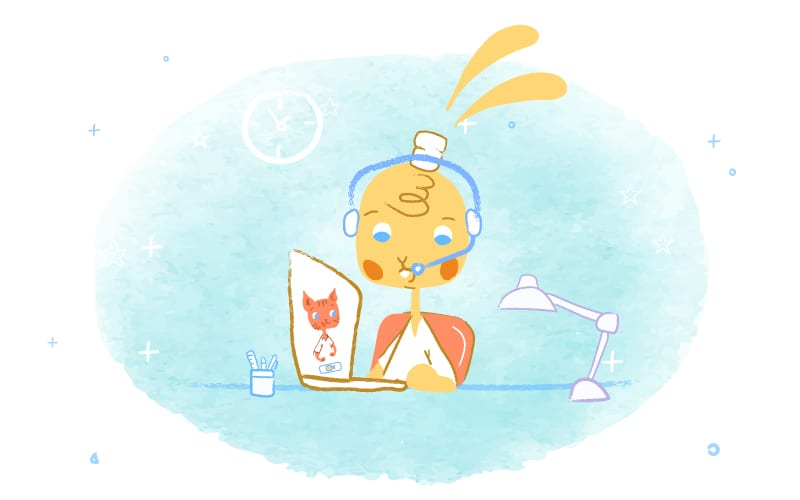

It’s the spooky season. And, is there anything more bone-chilling than the fear of failure?
A 2015 survey conducted by the social network Linkagoal found that 31% of 1,083 adults surveyed feared failure – a much higher percentage than people who hated spiders (30%), being alone at home (9%), or even the paranormal (15%).
Moreover, the Global Entrepreneurship Monitor (GEM), a research organization emphasizing entrepreneurship, found that the fear of failure has held back 33% of Americans from starting a business. But, what exactly is the fear of failure? And, more importantly, how can you stare it in the face and proclaim, “I ain’t afraid of no failure”?
What is the Fear of Failure?
Often referred to as Atychiphobia, the fear of failure is an irrational and recurring fear, notes Kendra Cherry for Verywell Mind. Usually, this fear arises in response to a particular circumstance. Alternatively, it may be associated with a mental health condition like anxiety or depression.
Perfectionism may also be associated with a fear of failure. Perfectionists may be prone to experiencing anxiety about whether they will be able to meet their unrealistic standards since they have such high expectations about how things should be.
What exactly causes the fear of failure? Well, some of the most common culprits include;
- Critical upbringing. Fear of failure is more likely to occur in people who are raised in highly critical or unsupportive homes. Those who were never able to measure up to their family’s expectations when they were young may still feel that making mistakes is too risky as an adult.
- Definitions of failure. Everyone defines failure differently. For some, it means failing to achieve what they were aiming for. Expectations of this kind are hard to meet.
- Trauma. Failure can be very traumatic for those who experience it. The individual may be very afraid of repeating the trauma — like losing out on a promotion or making mistakes during a presentation.
Symptoms of Atychiphobia
There is no universal way to experience fear. After all, intensity can range from mild to extremely intense. Atychiphobia happens to be more of an extreme type of fear as it can make it almost impossible to complete your regular daily tasks at home, school, or work. As a result, that means you could miss out on meaningful career and personal opportunities.
As with other phobias, Atychiphobia can cause other symptoms, such as anxiety and panic. Typically, they’re triggered by situations in which you might fail, and they may be physical or emotional. Your symptoms may even seem to appear suddenly in some cases.
You may experience physical symptoms such as;
- Breathing difficulties
- A heart rate that is unusually high
- Chest pain or tightness
- Shivering or trembling
- Lightheadedness or dizziness
- Digestion problems
- Cold or hot flashes
- Sweating
You may experience emotional symptoms such as:
- A feeling of intense panic or anxiety
- The overwhelming need to escape the fear-producing situation
- Self-disconnection
- A situation in which you don’t feel you can control
- A fear of death or passing out
- Feeling powerless in the face of your fears
If you suffer from Atychiphobia, you may also self-handicap. It means that you sabotage your efforts because you are afraid of failing. For instance, you may not call an investor for your business idea, thus leading to your failure. In this scenario, it would be better to start without trying than to try and then fail.
The Consequences of the Fear of Failure
When you fear failure, it can paralyze you at times. Many people believe that going after anything wouldn’t be worth it because all efforts are bound to fail. Giving up like this can cause missed opportunities and the inability to reach goals.
The potential negative consequences of such a mindset can go far beyond the failure to achieve a goal. Mental health, relationships, and overall quality of life are adversely affected by fear of failure. And, it can also potentially lead to;
- Procrastination or avoiding tasks
- Low self-esteem
- Low self-efficacy
- Reduced resilience
- Underperformance
- A sense of helplessness
- A high level of anxiety elsewhere in life
- A state of emotional instability and upheaval
In short, the fear of failure is counterintuitive. Since you’re terrified that you won’t reach a goal, you won’t even start. In turn, this inhibits you from living life to the fullest.
How to Overcome Your Fear of Failure
Thankfully, there are ways to overcome your fear of failure, like when Ray, Egon, Peter, and Winston defeated Gozer in Ghostbusters.
Where does your fear of failure originate?
When you have some alone time, quietly reflect on the root cause of your fear of failure. It might help to close your eyes and take some deep breaths. As you do, take note of your senses as you travel back to the formation of your fear of failure.
The act of seeing how your fear of failure came about also reveals how inaccurate your interpretation of the event is. For example, that teacher who was strict and rigid on you wasn’t Freddy Krueger. Instead, they saw your potential and wanted to challenge you so that you would reach it.
The importance of examining your negative beliefs cannot be overemphasized. After all, your beliefs shape the way you act and react.
Answer your “what if” questions.
“What if I fail my midterm?” “What if I actually get fired?” “What if I get caught doctoring photos and test scores so my kid can get into USC?” “Well, OK, maybe that one is uniquely specific, but the question probably should have been asked, writes Ellen Hendriksen, Ph.D. in Psychology Today.
“Often, we’ll voice our worries with all sorts of ‘what if’ questions, Dr. Hendriksen adds. “Therefore, to get over your fear of failure, actually answer the question: If your fear came to pass, what would you do? How would you cope? Who could comfort you?”
Take a moment to consider how you would cope with failure, like not meeting a deadline or having to close your business. Instead of letting that happen, you could ask a colleague to help complete a project or talk to a financial advisor on how to tighten your budget.
“When you answer the ‘what if’ question, you work through the worst-case scenario and come out the other side with a plan,” she adds. “Suddenly, you know how you would either rectify the situation or take care of yourself and move on, which instantly makes things less scary.”
Try exposure therapy.
When it comes to conquering phobias, this is most likely the cringest option. However, it’s also one of the most effective.
Understanding that exposure alone is not sufficient in exposure therapy is key to its success. It needs to occur in a safe, protected, and comfortable environment. To put it another way, you can’t treat thalassophobia (fear of the sea) by throwing someone into the ocean. Instead, you would have to gradually get more comfortable in the water by first having them in swimming pools.
There are different forms of exposure therapy as well;
- Imaginal Exposure. Visualizing the fear as clearly as possible.
- VR Exposure. Immersion in a virtual environment. Fears such as heights, enclosed spaces, and insects can be treated effectively with this.
- In Vivo Exposure. Directly confronting the fear.
- Interoceptive Exposure. Educating people about the non-existence of feared but harmless sensations is sometimes helpful.
Visualize obstacles.
Students in two groups were asked to predict what would happen in their lives this week in a study published in the Journal of Experimental Social Psychology in 2011. One group was asked to imagine that their week would be wonderful. In the other group, the members were asked to jot down anything they thought about the week.
The students who imagined a great week reported feeling less energized and accomplishing less than the control group in the week.
However, simply thinking positively isn’t enough. Researchers have found that the best outcomes occur when we combine positive thinking with visualization of challenges in the future.
Suppose you’re afraid of failing in a specific situation, like public speaking. Allow yourself to feel that fear as you strike an obstacle, and then visualize yourself crushing the presentation. Next, spend a few minutes planning how you will get past all of the challenges you might encounter. And imagine yourself succeeding despite them.
Set approach, not avoidance, goals.
“Approach goals are those with positive outcomes that we work towards,” explains Bridget Grenville-Cleave, a positive psychology consultant, trainer, and writer. “Positive can mean different things in different contexts, such as liked, desirable, pleasurable, or beneficial.”
“Avoidance goals are those with negative outcomes that we work to avoid,” Greenville-Cleave adds. “Negative can mean different things, including disliked, undesirable, painful, or harmful.”
Avoidance goals are harmful to well-being, according to research. “In one study, participants with a greater proportion of avoidance goals reported lower subjective well-being over the course of the semester and had lower well-being at the end of the semester than they had at the start,” she writes. “In another study, therapy clients with more avoidance goals experienced smaller increases in subjective well-being than those with fewer.”
One explanation may be that constantly monitoring negative possibilities or looking for evidence of their absence drains your energy. Instead, it appears that creating approach goals or reframing avoidance goals in a more positive light can benefit well-being.
Take control.
When tasks or goals are overwhelming, there is often a sense of dread of failure. You can, however, feel more in control of a daunting project when you divide it into smaller, more manageable chunks. Also, reflecting on your accomplishments can help you make more confident decisions and ensure success in all components of life.
Write down the ways you typically approach tasks and your work habits. Next, determine what is working well for you and what is getting in your way. Then, make the most of what works for you and replace the things that don’t work for you with alternatives. Taking time to reflect and make decisions about your tasks can help you feel in charge, which can be empowering and motivating.
Give yourself permission to fail.
“Life is about messing up,” the authors over at the ProduKtive blog note. “That’s why many people who live the greatest lives possible, also profess to be the biggest screw-ups. It just comes with the territory.”
“So if we want to live the fullest life we can, we have to be willing to face the truth,” they add. “We have to be willing to find out who we are, what we can do, and just how much failure we can possibly take.”
In other words, you have to be willing to put yourself out there. And, you can do this by;
- Leverage the support around you, preferably those who don’t mind getting dirty.
- Take it one step at a time.
- Develop a plan and stick with it.
- Tack your progress and keep a log of your results.
When to Get Professional Help for Atychiphobia
Consider seeking professional help when fear of failure threatens your everyday life. A sense of failure interference means you cannot live your life to your full potential because of fear. For example, living in the “fear zone” can lead to problems starting or finishing tasks at work or home. Fear of failure may also prevent you from pursuing a passion or dream or prevent you from doing things you want or need to do.
In addition to interfering with relationships, fear of failure leaves you feeling unworthy or unable to be yourself around others. Reaching out for help may be beneficial if you notice your anxiety is negatively affecting your life.
Image credit: Nothing Ahead; Pexels; Thank you!











Deanna Ritchie
Editor-in-Chief at Calendar. Former Editor-in-Chief and writer at Startup Grind. Freelance editor at Entrepreneur.com. Deanna loves to help build startups, and guide them to discover the business value of their online content and social media marketing.